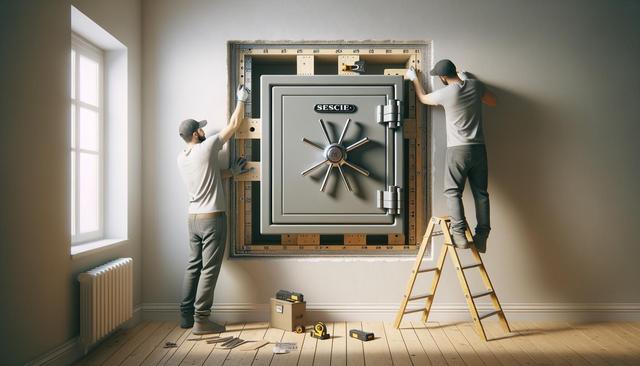Understanding the Importance of Safe Installation
When considering home or vehicle security, the installation of a safe is a critical step that should not be underestimated. Regardless of the type, a poorly installed safe can be vulnerable to theft, tampering, or even accidental damage. This is why understanding proper installation methods is essential when investing in a secure storage solution. Knowing why a home safe is worth it begins with realizing how installation directly affects its effectiveness. A secure and stable placement not only protects your valuables but also ensures quick access in emergencies.
Proper installation includes securing the safe to a solid structure, such as a concrete floor or a wall stud, to prevent removal. This also reduces the risk of tipping over, especially for larger models. Moreover, choosing the correct location — away from obvious places like the master bedroom or living room shelves — adds an extra layer of security. For in-vehicle safes, positioning is equally important. Ensuring that the safe is fixed in a hidden but accessible location can prevent smash-and-grab thefts, which are common in unattended vehicles.
Choosing the Right Safe for Your Needs
Before planning the installation, selecting the right type of safe is essential. The market offers a broad range of options depending on the intended use. Understanding the types of security safes available can help you make an informed decision. Common categories include:
- Fire-resistant safes: Designed to protect documents and digital media from high temperatures.
- Burglar-resistant safes: Built to resist forced entry using tools or blunt force.
- Wall and floor safes: Installed into the structure of your home for concealed protection.
- Gun safes: Engineered specifically to secure firearms and ammunition.
Each of these types has different installation requirements. For example, wall safes often need to be mounted between wall studs, while floor safes may require concrete anchoring. In-vehicle safes, on the other hand, are typically designed for specific car models and need professional fitting to ensure they don’t interfere with vehicle operations.
Professional vs. DIY Installation
Deciding between professional and DIY installation depends on your experience, the type of safe, and your home’s infrastructure. While DIY installation can be cost-effective, it may not always provide the level of security you need. For instance, a heavy-duty floor safe may require tools and expertise that most homeowners don’t possess. In contrast, some in-vehicle safes come with user-friendly installation kits, making them more suitable for DIY attempts.
Professional installation offers several advantages:
- Correct anchoring to walls or floors.
- Precise fitting of in-vehicle safes to avoid damage to the interior.
- Compliance with manufacturer warranties and insurance requirements.
However, if you choose to go the DIY route, ensure you follow the installation manual thoroughly and use all recommended tools and anchors. Also, consider hidden risks like electrical wiring or plumbing in your walls or floors before drilling.
Common Mistakes to Avoid During Safe Installation
Many people, even with the best intentions, make mistakes during the installation process that compromise the security of their safe. One common error is placing the safe in a highly visible location. This can make it an easy target for burglars. Another frequent mistake is failing to anchor the safe properly, making it easier to remove entirely.
Here are a few additional things to avoid:
- Ignoring weight limits for shelves or walls where the safe is mounted.
- Using incorrect or low-quality anchors and bolts.
- Overlooking ventilation needs, especially for electronic safes.
- Installing safes in damp areas, causing rust or electronic failure over time.
To avoid these pitfalls, take the time to assess your chosen location thoroughly and ensure that your installation approach matches the type of safe you’re working with. In-vehicle safes, for example, require consideration of vehicle usage patterns and should not obstruct airbag systems or electronics.
Maintaining Your Installed Safe
Once your safe is installed, proper maintenance ensures it continues to function as expected over time. A safe’s performance can degrade if it’s not checked regularly for wear, rust, or electronic issues. This is particularly important for in-vehicle safes, which are subject to constant movement and temperature changes.
Maintenance tips include:
- Regularly checking bolts and anchors for tightness.
- Cleaning the locking mechanism and keypad to prevent buildup.
- Monitoring humidity levels inside the safe, especially for paper or electronics.
- Testing backup keys and emergency override features periodically.
Understanding why a home safe is worth it includes recognizing that the protection it offers is only as good as its upkeep. Similarly, in-vehicle safes may require more frequent inspections due to the dynamic environment in which they operate. Keeping up with maintenance ensures your investment continues to deliver the intended level of security.
Conclusion: Secure Your Peace of Mind
Installing a safe correctly is a crucial step in enhancing your personal and property security, whether at home or on the road. From understanding the types of security safes available to knowing the nuances of in-vehicle safes, each aspect plays a role in creating a secure environment. Knowing why a home safe is worth it becomes more evident when the installation is done properly and thoughtfully. By avoiding common mistakes, choosing the right type of safe, and maintaining it regularly, you can ensure long-lasting protection and peace of mind.




Leave a Reply